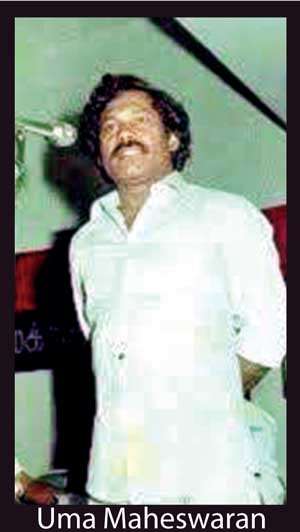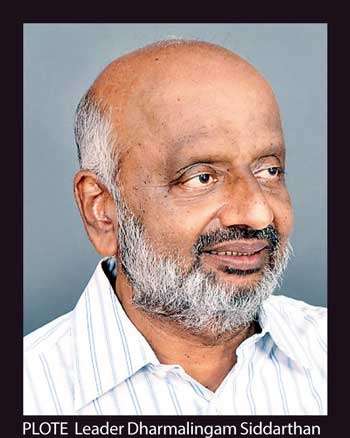19 Feb 2019 - {{hitsCtrl.values.hits}}
 February 18 was the 73rd birth anniversary of Uma Maheswaran. Uma, the founding leader of the People’s Liberation Organisation of Thamileelam (PLOTE) was born on 18 February 1945. He was killed -a victim to a cowardly assassin’s bullet- on July 16, 1989, at the top of Frankfurt Place in Bambalpitiya.
February 18 was the 73rd birth anniversary of Uma Maheswaran. Uma, the founding leader of the People’s Liberation Organisation of Thamileelam (PLOTE) was born on 18 February 1945. He was killed -a victim to a cowardly assassin’s bullet- on July 16, 1989, at the top of Frankfurt Place in Bambalpitiya.
I first came to know Uma while he was one of many young Tamil men and women who volunteered to help set up refugee camps in the north, in the aftermath of the 1977 general elections. In an effort to subdue and instill fear into all possible opponents who he felt might be opposed to his plans to privatise the economy, then premier JR Jayewardene unleashed mobs against his opponents, even against the upcountry Tamils.
 At that time I was the Secretary of the Development Commission (DC) of the National Christian Council (NCC). It was my job to help plan a programme to provide relief to the displaced estate families who had been affected by the Government sponsored pogrom. Around 30,000 people were affected and most of them Up-country Tamils; many more were injured and driven away from the estates on which their families had toiled for over a century.
At that time I was the Secretary of the Development Commission (DC) of the National Christian Council (NCC). It was my job to help plan a programme to provide relief to the displaced estate families who had been affected by the Government sponsored pogrom. Around 30,000 people were affected and most of them Up-country Tamils; many more were injured and driven away from the estates on which their families had toiled for over a century.
According to ‘Skantha’ the then PLOTE spokesman, even though the man who murdered Uma was known to the organisation and was subsequently executed in Europe, the master-mind/s behind the planned killing are not clear.
Skantha rubbished the claims of a PLOTE splinter group led by ‘Paranthan Rajan’ who claimed responsibility for the killing. Rajan and his group are being maintained by the Indian intelligence services he said. Their claim to having organised the killing of Maheswaran is probably at the ‘request’ of their masters.
At the time of Uma’s death Skantha continued, Sri Lanka was in turmoil. The country’s north and east were under the occupation, of the Indian army -with troops of the ‘Indian Peace Keeping Force’- totally controlling that part of the country.
The Sri Lankan Army, under terms of the agreement, which Jayewardene’s Government acquiesced to was largely helpless and confined to barracks.
President Premadasa who had always opposed to the presence of the India’s military in the country, was in a dilemma. He had already demanded India remove it’s ‘Peace Keeping Force’ which was fighting the LTTE.
At the same time the JVP had opened a second front to the war via its southern insurgency.
Premadasa was aware that he could not fight a battle on two fronts -against the LTTE and the JVP- both of whom had wide support among the common people in their respective areas.
He also had intelligence that the JVP was in contact with Uma and the PLOTE.
Uma always believed the unity between the Sinhalese and Tamil working class was necessary, to overcome the system which oppressed them and install a people’s regime. Even during the formative days of PLOTE he lectured on the dangers of Indian intervention and subversion.
Organised classes
 He emphasised this point in one of PLOTE’s first documents - ‘The Lessons of Bangladesh’. He also organised and operated Sri Lanka’s first underground radio station -The Voice Of Thamileelam ((VOTE)- broadcast in Tamil, Sinhalese and English as a means of educating all sections of the population on the need to work on a common programme to defeat the capitalist system.
He emphasised this point in one of PLOTE’s first documents - ‘The Lessons of Bangladesh’. He also organised and operated Sri Lanka’s first underground radio station -The Voice Of Thamileelam ((VOTE)- broadcast in Tamil, Sinhalese and English as a means of educating all sections of the population on the need to work on a common programme to defeat the capitalist system.
A separate school on Marxist doctrine was also set up to wean incoming cadres away from Tamil nationalism and racism. Ms. Kumaratunge during a visit to Uma’s Chennai office expressed her appreciation at the manner in which the classes were organised.
Uma also contacted SLFP Leader Ms Sirimavo Bandaranaike, and paid his respects to her, when he together with D. Sivaram and I, called at her residence at Rosmead Place shortly after the IPKF arrived in the island. During this time he also called on Vijaya Kumaratunge and Ms Chandrika Kumaratunge, who went on to become the first woman president of the country. He also met with all Marxist party leaders.
To his credit Uma went out of his way to dialogue with even the leadership of the more Sinhala right wing organisations as well.
Uma also contacted SLFP Leader Ms Sirimavo Bandaranaike, and paid his respects to her, when he together with D. Sivaram and I, called at her residence at Rosmead Place shortly after the IPKF arrived in the island
It was to help bring about rapprochement between the divided Sinhalese and Tamil communities that Uma together with the Mr. Rukman Senanayake, Mr. Sidthadthan and I visited the then heads of the Malwatte and Asgiriya Chapters to explain to them the reasons and goals of the Tamil struggle for freedom. Uma’s visit to the Ven. Monks’ abode was reported in the ‘Sun’ newspaper.
The Rev priests extended every courtesy to Uma while also suggesting that the actions of some groups among the Tamil militants were driving sections among the Sinhalese to hold extremist views on the ethnic issue.
Mr. Senanayake at that time, had left the UNP as he was opposed to racist politics of President Jayewardene. Rukman believed the divisive politics of Jayewardene was leading the country to its destruction.
Uma’s words and actions were totally supportive of the Sri Lankan people. ‘India he emphasised was a backyard to run to when we needed to hide’.
So it was not surprising that the Indian authorities were not happy of Uma’s politics and his political stances. They also knew he was maintaining contacts with Sri Lankan left parties and with the Sri Lanka Freedom Party (SLFP).
Though it surprised him, when the Indian authorities disarmed PLOTE, he should not have been. They recognised his leadership would not accept orders to the detriment of the Sri Lanka or its people.
It was while he was working among the displaced upcountry Tamil population that Uma found himself growing more and more disenchanted with the so-called democratic politics in the country.
Seeing more of Prabakaran
“A democracy which permits mobs to attack innocents -in this case the tea estate workers- with impunity is not democracy” he told me. “It is fascist and we need to confront the fascists, bring them to book and overthrow the regime which uses fascism to control the masses.
It during this time, when Uma’s mind was in turmoil that he began to see more and more of Prabakaran, whom he knew, but disagreed with, on the means the freedom struggle should take. Prabakaran was also helping provide relief to the displaced upcountry Tamils.
Uma’s interactions with Prabakaran were now moving towards a different plane. Uma had become convinced that the non-violent struggle as led by the TULF was no longer viable.
By late 1977 Uma joined Prabakaran in The New Tigers (TNT) . Shortly after Uma joined the TNT Mr. Eliathamby Ratnasabapathy -a London-based Tamil and founding father of the Eelam Revolutionary Organisation of Students (EROS) organised the first arms training programme and invited the leader of the TNT to participate in the programme.
Prabakaran, who was not proficient in any language but Tamil, suggested Uma attend the programme. Since criteria to attend such a programme required a person in a leadership position versed in English, Prabakaran proposed to the central committee of the TNT, that Uma be appointed Chairman and proceed to the training programme.
Subsequently, under Uma’s Chairmanship of the TNT, the name of the organisation was changed to the Liberation Tigers of Tamil Eelam (LTTE).
After returning from his training, Uma’s relationship with Prabakaran began to undergo numerous strains.
According to Uma the main point of divergence was Prabakaran’s mode of settling disputes within the organisation as well as his dealing out kangaroo-court justice to individuals whom he suspected of illegally using party funds and or consuming liquor.
The Rev priests extended every courtesy to Uma while also suggesting that the actions of some groups among the Tamil militants were driving sections among the Sinhalese to hold extremist views on the ethnic issue
The final straw came when Prabakaran killed a senior member -Setty- a senior militant who had been involved in the freedom struggle over a long period of time. At the Central Committe Meeting after Setty’s killing, Uma berated Prabakaran and demanded he stop killing of members of the organisation based on his suspicions.
Prabakaran’s answer to Uma came in the form of taking out his pistol, placing it in front of Uma and saying to him, “...periyavar, if I have done wrong and this man is innocent of having misused party funds for his personal use, here is my gun... Take it and shoot me...”
At this point Uma told me that he knew he could not work together with Prabakaran any longer. It was then that Uma began roping into the LTTE members of the TULF youth wing, as well as other young people who backed his theories on the need to join hands with like-minded Sinhalese and other ethnic groups to combat growing racism and extreme nationalism in the country.
Leaving the LTTE
Uma’s new strategy was violently opposed by Prabakaran who believed his appointee as Chairman of the LTTE was intent on breaking the organisation. He demanded Uma stop these activities and accused him of having a clandestine relationship with a female member of the organisation.
The accusations and counter accusations led to the acrimonious parting of ways between Uma and Prabakaran. Knowing Prabalkaran’s mindset Uma left the LTTE and moved to the east where he was cared for by poor Tamil fisher people and farmers.
“It was here that my belief in Marxism was strengthened” he told me, while the people of Jaffna -those of so-called high caste and even my relations- were afraid to associate with me for fear of Prabakaran. But, the poor farmers and fisher-people in Batticaloa offered me shelter...
In the ultimate Uma was killed in July for his attempt to keep Sri Lanka free from all forms of external interference.
It is not that Uma was a figure who could be compared with giants like Martin Luther King Jr. or a Nelson Mandela.
He had his faults and many serious ones, -like for instance the support he extended to the coup leader Abdul Luthufi in the Maldives in 1988. But, to take a leaf out of Dr. Colvin R. de Silva’s ‘Ceylon under British Rule’ if it was the racism of particular Sinhalese leaders that led to the burgeoning ethnic crisis in Sri Lanka, it was the steadfastness of Uma Maheswaran’s belief that ordinary Sinhalese and Tamils needed to work together to overthrow the capitalist shackles which bound them, which prevented the Tamil freedom struggle from taking a racist turn.
30 Nov 2024 42 minute ago
30 Nov 2024 3 hours ago
30 Nov 2024 4 hours ago
29 Nov 2024 29 Nov 2024
29 Nov 2024 29 Nov 2024